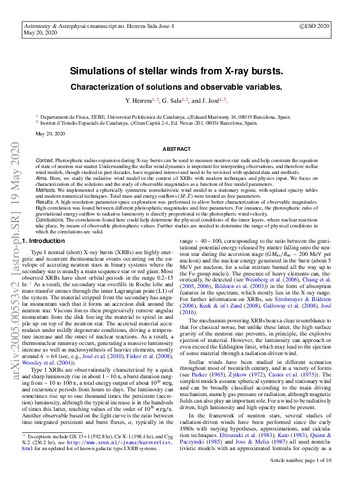Mostra el registre d'ítem simple
Simulations of stellar winds from X-ray bursts: Characterization of solutions and observable variables.
| dc.contributor.author | Herrera, Yago |
| dc.contributor.author | Sala Cladellas, Glòria |
| dc.contributor.author | José Pont, Jordi |
| dc.contributor.other | Universitat Politècnica de Catalunya. Departament de Física |
| dc.date.accessioned | 2021-02-10T17:14:38Z |
| dc.date.available | 2021-02-10T17:14:38Z |
| dc.date.issued | 2020-06-19 |
| dc.identifier.citation | Herrera, Y.; Sala, G.; Jose, J. Simulations of stellar winds from X-ray bursts: Characterization of solutions and observable variables. "Astronomy and astrophysics", 19 Juny 2020, vol. 638, p. 1-10. |
| dc.identifier.issn | 0004-6361 |
| dc.identifier.other | arXiv:2005.00553v2 |
| dc.identifier.uri | http://hdl.handle.net/2117/338375 |
| dc.description.abstract | Context. Photospheric radius expansion during X-ray bursts can be used to measure neutron star radii and help constrain the equation of state of neutron star matter. Understanding the stellar wind dynamics is important for interpreting observations, and therefore stellar wind models, though studied in past decades, have regained interest and need to be revisited with updated data and methods. Aims. Here, we study the radiative wind model in the context of X-ray bursts with modern techniques and physics input. We focus on characterization of the solutions and the study of observable magnitudes as a function of free model parameters. Methods. We implemented a spherically symmetric nonrelativistic wind model in a stationary regime, with updated opacity tables and modern numerical techniques. Total mass and energy outflows (¿, E) were treated as free parameters. Results. A high-resolution parameter-space exploration was performed to allow better characterization of observable magnitudes. High correlation was found between different photospheric magnitudes and free parameters. For instance, the photospheric ratio of gravitational energy outflow to radiative luminosity is directly proportional to the photospheric wind velocity. Conclusions. The correlations found here could help determine the physical conditions of the inner layers, where nuclear reactions take place, by means of observable photospheric values. Further studies are needed to determine the range of physical conditions in which the correlations are valid. |
| dc.format.extent | 10 p. |
| dc.language.iso | eng |
| dc.publisher | EDP Sciences |
| dc.rights | Attribution-NonCommercial-NoDerivs 3.0 Spain |
| dc.rights.uri | http://creativecommons.org/licenses/by-nc-nd/3.0/es/ |
| dc.subject | Àrees temàtiques de la UPC::Física |
| dc.subject.lcsh | Stars |
| dc.subject.lcsh | X-Rays |
| dc.subject.other | X-rays: bursts |
| dc.subject.other | Stars: winds |
| dc.subject.other | outflows |
| dc.subject.other | Stars: neutron |
| dc.subject.other | Methods: numerical |
| dc.title | Simulations of stellar winds from X-ray bursts: Characterization of solutions and observable variables. |
| dc.type | Article |
| dc.subject.lemac | Estels |
| dc.subject.lemac | Raigs X |
| dc.contributor.group | Universitat Politècnica de Catalunya. GAA - Grup d'Astronomia i Astrofísica |
| dc.identifier.doi | 10.1051/0004-6361/201936895 |
| dc.description.peerreviewed | Peer Reviewed |
| dc.relation.publisherversion | https://www.aanda.org/articles/aa/abs/2020/06/aa36895-19/aa36895-19.html |
| dc.rights.access | Open Access |
| local.identifier.drac | 28860780 |
| dc.description.version | Postprint (published version) |
| local.citation.author | Herrera, Y.; Sala, G.; Jose, J. |
| local.citation.publicationName | Astronomy and astrophysics |
| local.citation.volume | 638 |
| local.citation.startingPage | 1 |
| local.citation.endingPage | 10 |
Fitxers d'aquest items
Aquest ítem apareix a les col·leccions següents
-
Articles de revista [2.208]
-
Articles de revista [299]


